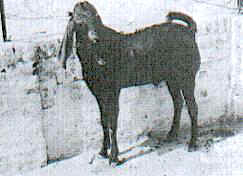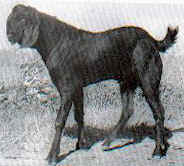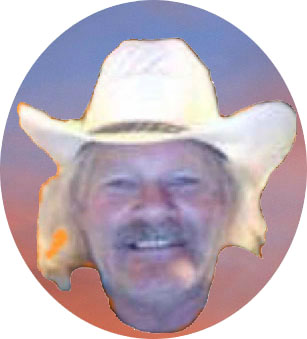|

|
Distribution
Throughout the States of Punjab and Haryana. True-bred animals are however found in the districts of Gurdaspur, Amritsar and Ferozepur in Punjab.

|

|
Numbers
The total goat population in the Beetal distribution area, according to the 1972 livestock census, was 0.159 m, of which 0.014 m adult males and 0.084 m adult females. The goat population of Punjab has shown a marked decline. Surveys carried out by the Division of Dairy Cattle Genetics of the National Dairy Research Institute (NDRI) showed that both the number of flocks and the number of goats per flock have decreased, primarily owing to an; increase in; irrigated cultivated areas and the shortage of natural vegetation available for browsing. Beetal is a good dairy breed, second to Jamnapari in size but is superior to it in that it is more prolific and more easily adaptable to different agro-ecological conditions and to stall-feeding. Jamnapari is more sensitive.
Climate
| Average monthly temperature (ºC) |
Average |
Range |
|
minimum |
17.3 |
5.8-27.1 |
|
maximum |
31.9 |
20.2-41.2 |
| Average monthly relative humidity (%) |
|
morning |
66 |
37-83 |
|
evening |
44 |
22-66 |
| Annual rainfall (cm) |
70.4 |
Breed Characteristics
|
Adult males |
Adult females |
| Body weight |
59.07 |
34.97 |
| Body length |
85. |
70.42 |
| Height at withers |
91.60 |
77.13 |
| Chest girth |
86.0 |
73.7 |
Conformation
Conformation: Large anima1s. Variab1e coat color, predominant1y black or brown with white spots of differing sizes. In a survey conducted by NDRI in the home tract of the breed, 92.6% animals were black and 7.4% brown. The coat is short and 1ustrous. The face 1ine is convex, with typical Roman nose but not as prominent as in Jamnapari. Ears are long and f1at, curled and drooping ear length: 24.8 t 0.65 cm (18) Both sexes have thick, medium-sized horns, carried horizontally with a slight twist directed backward and upward; horn length: 11.95 t 0.76 cm . Tail is small and thin. The udder is large and well developed, with large conical teats.
Flock structure
The average flock contains 21.06 + 1.92 individuals, of which 1.5 adult males, 11.7 adult females and 7.8 young.
Reproduction
|
|
Days |
| Age at first kidding |
761 |
| Kidding interval |
368 |
| Service period |
160 |
| Kidding percentage |
176 |
| Litter size: (%) |
| Singles |
40.66 |
| Twins |
52.6 |
| Triplets |
6.52 |
| Quadruplets |
0.22 |
Mortality
| Pre-weaning |
25.4 |
| Adults |
13.2 |
Breeding
Breeding: Pure breeding. Breeding males are generally selected on the basis of their dam's milk yield. The services of a buck of a neighboring owner are commonly utilized when a flock does not possess a buck.
Performance
|
Milk |
| Lactation yield |
177.38 |
| Lactation length |
187.0 |
|
Meat Kg |
| At birth |
2.80
|
| At weaning |
9.26
|
| 6 months |
12.18 |
| 9 months |
15.42
|
| 12 months |
21.83 |
|
Hair |
|
- |
Reference:
All information and photographs contained here are posted in conjunction and cooperation with Goats in India and Mrs. Farza Panhwar of Pakistan. For additional information, please visit the Goats in India web site or email Capra@iespana.es.
About the author:

|
About the author: Gary Pfalzbot is a Service Connected Disabled Veteran and the web master of GoatWorld as well as some other web sites. He has raised goats over the years, been involved with 4-H (as a young boy) and currently resides in Colorado where he and his wife Pam raise a few breeds of goats and other animals, and primarily author the GoatWorld web site to continue to inform, educate, and promote the industry.
|
|
|










